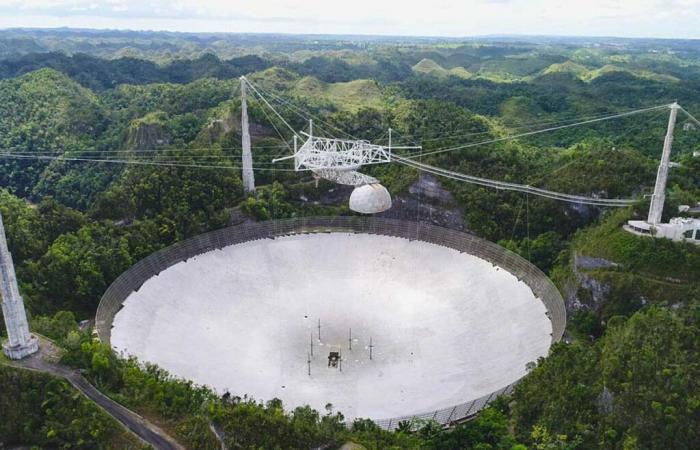The Arecibo Observatory, a giant of radio astronomy, has been for decades one of the most important instruments for the study of the Universe. Its imposing structure, with a reflector 305 meters in diameter, was one of the largest telescopes in the world, a true scientific treasure. However, in 2020, a spectacular collapse brought this era to an end. What happened to cause this emblematic observatory, which has served science since 1963, to be permanently lost? Here's what really led to the Arecibo Observatory's tragic end.
A legendary telescope
Arecibo Observatory opened in 1963 in Puerto Rico. From its beginnings, it has occupied a leading place in the field of radio astronomy. With its immense spherical reflector of 305 meters in diameterit was capable of capturing signals from the most distant corners of the Universe. It thus made it possible to make major discoveries, such as the detection of the binary pulsar in 1974, an exploit which earned a Nobel Prize in physics for Russell Hulse and Joseph Taylor in 1993. In 1992, he was also the first to discover exoplanets around a pulsar, an important milestone in astronomy.
The observatory has also played a strategic role in research on the ionosphere and the monitoring of near-Earth objects. For more than 50 years, it was a beacon for science. However, over the years, the aging infrastructure began to show signs of signs of weaknessheralding what would become a series of preventable disasters.
The first signs of deterioration
The problems started in 2017 with the arrival of Hurricane Maria. This passage exerted extreme pressure on the telescope's support cables, which were subjected to unprecedented tensions. Although initial inspections revealed no major damage, the cables had still been weakened by the strong winds. Repairs were proposed, but were delayed due to complex maintenance management, logistical problems and budgetary constraints. The teams did not anticipate that this pressure could lead to long-term damage and the fragile components of the telescope continued to deteriorate without being properly taken care of.
A gradual weakening
It was not until several years after the hurricane that the deficiencies became evident. A detailed report from the National Science Foundation (NSF) highlighted the gradual degradation of support cables. A crucial factor in this deterioration has been the phenomenon you fly you zinc. This is a slow process in which metal cables, mainly composed of zinc, degrade over time. This problem had not been adequately addressed during initial post-hurricane inspections, leaving the observatory increasingly vulnerable to imminent collapse.
The report also revealed that a series of hidden breaks in exterior cableswhich occurred due to zinc creep, had not been detected during controls. These ruptures thus considerably weakened the structure of the observatory, which worsened its fragility. The failing cables gradually weakened the observatory's ability to support its own weight.
Major failures
In August and November 2020, two auxiliary cables showed signs of major failure, followed in November by the rupture of a main cable. This latest incident precipitated a difficult decision by the NSF: decommission the observatory and begin a controlled dismantling to avoid an even more serious accident. However, despite this preventive decision, on December 1, 2020, another already weakened cable gave way, causing the collapse of the observation platform. The latter crashed into the lower structure, severely damaging the support towers and other nearby buildings. Fortunately, no injuries were reported, but this collapse marked the final end of the observatory.
Arecibo's legacy
Despite this tragic end, the legacy of the Arecibo Observatory endures. Although the telescope itself is out of commission, the NSF announced that the site would be transformed into a scientific education and research centerunder the name Arecibo C3. This new center will focus on science, technology, engineering and mathematics (STEM) education, ensuring that the observatory's scientific legacy continues to inspire future generations of researchers and students.
The Arecibo Observatory will remain a symbol of human scientific ambition and an instrument that has enabled extraordinary discoveries. However, its collapse also reminds us of the importance of rigorous and proactive maintenance to preserve these instruments essential to understanding the Universe.






